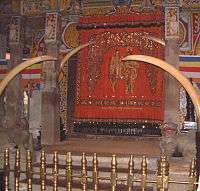Relic of the tooth of the Buddha
The Sacred Relic of the tooth of Buddha (Pali danta dhātuya) is venerated in Sri Lanka as a cetiya "relic" of Gautama Buddha, the founder of Buddhism.
History
The relic in India
According to Sri Lankan legends, when the Buddha died in 543 BCE, his body was cremated in a sandalwood pyre at Kushinagar and his left canine tooth was retrieved from the funeral pyre by his disciple, Khema. Khema then gave it to King Brahmadatte for veneration.[1] It became a royal possession in Brahmadatte's country and was kept in the city of Dantapuri (modern Puri, Odisha).
A belief grew that whoever possessed the tooth relic had a divine right to rule that land.[2] The Dāṭhāvaṃsa recounts the tale of a war fought over the relic 800 years later between Guhasiva of the republic of Kalinga and a king named Pandu.[3]
The relic in Sri Lanka

Legend states the Abhayagiri vihāra was first appointed custodianship of the relic when it was brought to the island after the conflict in Kalinga. As time went on, the land was threatened with foreign invasions; at one time, the king of Bago, Burma offered the Portuguese £50,000 as a ransom of the tooth;[1] and the seat of the kingdom was moved from Anuradhapura to Polonnaruwa, then to Dambadeniya and other cities. Upon each change of capital, a new palace was built to enshrine the relic. Finally, it was brought to Kandy where it is at present, in the Temple of the Tooth.[2]
The relic came to be regarded as a symbolic representation of the living Buddha and it is on this basis that there grew up a series of offerings, rituals, and ceremonies. These are conducted under the supervision of the two Mahanayakas of Malwatte, Asgiriya chapters, and Diyawadana Nilame of the Maligawa. These have a hierarchy of officials and temple functionaries to perform the services and rituals.
Other tooth relics
Aside from the relic in Sri Lanka, several relics in other countries are also reputed to have a tooth-relic of the Buddha.
- Lingguang Temple (灵光寺) of the Badachu Park in Beijing, China.[4]
- Buddha Memorial Center (佛陀紀念館) of the Fo Guang Shan Monastery in Kaohsiung, Taiwan.[5]
- Engaku Temple in Kamakura, Japan.[6]
- Buddha Tooth Relic Temple and Museum (佛牙寺龙华院) in Chinatown, Singapore.[7]
- Lu Mountain Temple in Rosemead, California[8][9]
- Nagarjunakonda, museum on the island situated in the Nagarjunasagar Lake.[10]
- Baoxiang temple, buddhist temple and monastery in Wenshang county, Jining city, Shandong province, China
See also
References
- 1 2 "The Buddha's Tooth". About.com. Retrieved May 12, 2013.
- 1 2 "Top 10 Religious Relics". Time. April 19, 2010. Retrieved May 12, 2013.
- ↑ Dhammakitti (1874). The Daṭhávansa; or, The history of the tooth-relic of Gotama Buddha [by Dhammakitti]. Tr., with notes, by Mutu Coomára Swámy.
- ↑ "The Eight Great Temples in the Western Hills (Badachu)". china.org.cn. Retrieved May 12, 2013.
- ↑ "History: Fo Guang Year 32". Fo Guang Shan Monastery. Retrieved May 12, 2013.
- ↑ "Temple Name: Engaku-ji". Rinzai-Obaku Zen. Retrieved May 12, 2013.
- ↑ "The History of the Buddha Tooth Relic Temple & Museum". Buddha Tooth Relic Temple. Retrieved May 12, 2013.
- ↑ "No April Fools': Followers Claim Rare Buddha's Tooth With Healing Powers Continues to Grow". NBC. Retrieved May 12, 2013.
- ↑ "The 10,000 Relics Collection". Bodhi Light International. Retrieved May 12, 2013.
- ↑ City information of Hyderabad, Nagarjunasagar, Nagarjunakonda, Warangal, Medak

